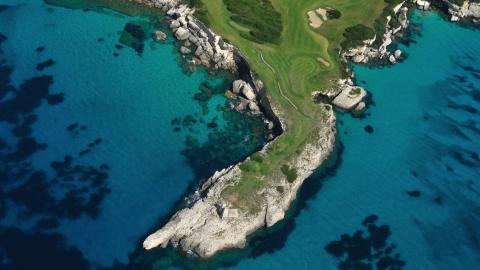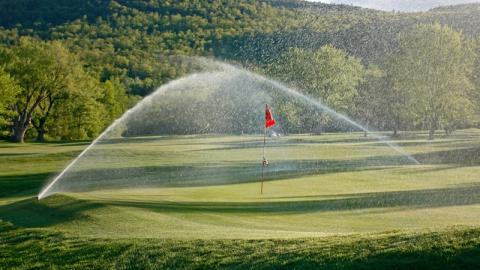Conserving 250,000 to 300,000 cubic metres of drinking water per year. This is the objective of the treated waste water reuse project undertaken by the municipal authorities of Hérault Méditerranée for the irrigation of the municipal golf course in the town of Agde.
It is a major challenge. With the population increasing from 27,000 inhabitants in the winter to 300,000 during the summer due to the number of visitors flocking to the seaside resort of Cap d’Agde, the town is experiencing a situation of water stress.
At Cap d’Agde, a three-stage project was launched at the end of 2017 to succeed in fully irrigating the 27-hole golf course with waste water between now and 2021.

The golf course as it was before the project
Opened in 1989, the international 18-hole golf course of Cap d’Agde, designed by the American architect Ronald Fream, covers around 78 hectares. In the light of its success and increased number of visitors, another 9 holes were added to the course in 2003. The golfers are now able to play on three 9-hole courses: Azur, Alize and Volcan. The total area of the golf course is 115 hectares.
The golf course receives water from an open-air reservoir with a capacity of 5000 m3. It is fed by a drinking water supply pipeline and by the rain waters from the city of Agde. The water is pumped from this reservoir by a pumping station consisting of five 80 m3/h pumps and conveyed to an irrigation network 40 km in length for the initial 18 holes with an extra 15 km for the extension.
In 2014-2015, the potable water consumed by the golf course was 329,000 m3/year, including more than 260,000 m3 per year for irrigation. The irrigation of the golf course barely covered the amount required for the growth of the grass and some areas even showed signs of water deficit during the year.
Connection to the city waste water system
Bearing in mind the pressure on water resources during the summer, the Agde city council has finally received approval to irrigate with the city’s waste water. The city authorities have been working on this project for 5 years and they have finally reached a favourable outcome. This has been achieved as a result of a change in legislation involving, in particular, the possibility of carrying out low pressure sprinkling near private dwellings and guidelines relating to the weather conditions.
Another catalyst for the completion of the project: the financial support of the Rhône Basin and Mediterranean Region Water Agency (Agence de l’Eau Rhône Méditerranée Corse). This organisation provided 80% of the total cost of the project, amounting to 55 million Euros ex-tax. The remaining 20% was borne by the organisation Lyonnaise des eaux.
The city council opted for a system that uses membrane ultrafiltration for the extension of the waste water treatment plant. This innovative procedure allows for waste water to be used by incorporating all the criteria required for ‘bathing water’ quality achieved at the outlet of the treatment plant. This is quite sufficient for irrigating a golf course, particularly since an additional chlorination system has been installed. Without the membrane ultrafiltration technique, the project would never have got off the ground.
The treatment plant for the town of Agde is located 2.5 km from the golf course. The organisation Lyonnaise des eaux has installed a 3 km. pipeline to connect the treatment plant to the golf course, the pumps discharging the treated waste water into a 1600 m3 reservoir created in the golf course. Water is constantly running into this reservoir (self-filling).
Anything located near the houses, closer than the throw radius of two sprinklers (i.e. almost 50 metres), cannot be irrigated with waste water, because that is forbidden. Furthermore, as a precautionary measure, the sprinklers cannot be started with a wind speed of more than 20 km/h so as not to wet the neighbouring dwellings. Thus, the open-air reservoir, supplied by the potable water pipes, has been retained and potable water is used when such a situation arises. The setting-up of a mixed system is in process.
A new irrigation system
The sprinklers were 30 years old and the installation, consisting of glued PVC pipes, was incompatible with the use of waste water. The installation, therefore, had to be rebuilt in its entirety. The work was carried out in several stages, during the off-peak season, so as not to inconvenience the players. Only six holes have been completed so far. Within the golf course, electrofusion welded PE pipes have been laid using the mole plough technique, which avoids leaving large trenches in the greens. The sprinklers have been repositioned using the new triangular irrigation layout, in order to obtain an optimum coefficient of uniformity for the irrigation water. Saving water becomes even more important when there are more sprinklers. The installation has Rain Bird part- (sector) and full-circle sprinklers working side by side, as well as Rain Bird’s Nimbus central control system. The first 6 holes were commissioned in March 2019 and they are irrigated with the city’s waste water.
The work will be carried out in three stages spread over 3 years. The first phase was carried out from September 2018 to March 2019 so as not to disturb the golfers. It was handed over prior to the summer 2019 season. The nine additional holes will be equipped from September 2019 to March 2020 and the final nine holes from September 2020 to March 2021. At the end of the work, 70% of the golf course will be irrigated with waste water.
Savings on water and fertilisers
This new installation should, in the long term, allow for 200,000 m3 of drinking water to be saved each year and the yearly water bill will be reduced by €120,000. Furthermore, the waste water applied to golf courses, even though it has been particularly well filtered by the membrane system, still contains a certain proportion of nitrate or phosphate compounds. These elements that fertilise the grass are normally applied separately by the greenkeeper. Therefore, this would allow for a 20% saving on fertiliser products, i.e. 3500 kg/year.
Furthermore, the fact of having a resource available on a permanent basis, in combination with the installation of a more efficient irrigation system, will significantly improve the quality of the grass. This will make the golf course more attractive.
We are part of a circular economy because those in charge of the golf courses would most benefit from this scenario during the summer months, when the golf courses require most water. The more people there are at the seaside resort, the more waste water they will produce. Thus, the Cap d’Agde golf course is not affected by the restrictions that generally have a strong impact on golf courses.


